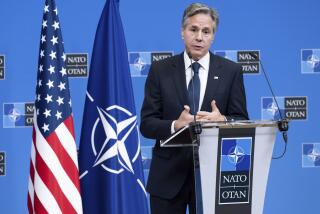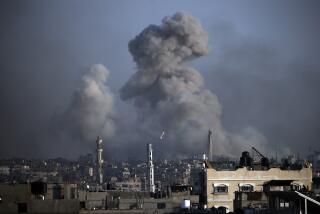Avowals Aside, U.S.’ Afghan Role Has Become That of Peacekeeper
- Share via
WASHINGTON — Despite protestations by the Pentagon that it wants no part of the peacekeeping mission in Afghanistan, the military campaign has itself evolved into an elaborate police action aimed at quieting local warlords, securing the country’s fledgling government and protecting the more than 4,000 U.S. troops in the country against sniper fire.
The search for Osama bin Laden and Mullah Mohammed Omar, meanwhile, has slowed as the number of potential sites dwindles, raising questions about the longer-term mission in Afghanistan.
Defense Secretary Donald H. Rumsfeld continues to argue against a U.S. peacekeeping role in the country. But he acknowledged last week that such a mission could become the endgame for American forces, as the military battles to prevent Afghanistan from again becoming a haven for terrorists.
“It’s in our interests as a country to take the kinds of steps . . . to assist that country in providing a more stable and secure environment,” Rumsfeld said.
American officials have publicly pledged not to walk away from Afghanistan once the hunt for Bin Laden is over. But rather than commit U.S. troops to keeping the peace, Rumsfeld has touted the establishment of an Afghan army to provide stability and security during rebuilding efforts.
Establishing such an army, however, will take time. Meanwhile, U.S. troops are taking fire almost daily from unseen assailants, and have been forced to take sides in a foggy military landscape in which it is increasingly difficult to distinguish friend from foe.
Pentagon and U.S. intelligence officials stress that Bin Laden and Omar are still being pursued. But there have been few signs of progress, and the search has been increasingly minimized in Washington.
In his recent testimony on Capitol Hill, CIA Director George J. Tenet did not mention the status of the search for Bin Laden in his remarks. When asked whether Bin Laden was still alive, Tenet said he didn’t know.
Gen. Richard B. Myers, chairman of the Joint Chiefs of Staff, told “Fox News Sunday” that the “odds are he probably is alive. We will get Bin Laden.” But in another televised interview Sunday, on ABC-TV’s “This Week,” Myers stressed that capturing the Al Qaeda leader is not “a prime mission” of the anti-terror campaign.
There are also signs that the United States is less committed than it once seemed to a painstaking search of the vast network of caves where Bin Laden was once believed to be hiding. Gen. Tommy Franks, commander of the U.S. Central Command, told Congress recently that some caves have been bombed so thoroughly that it is “not worth our energy to go and completely dig them out.”
As American troops pull back from the caves and get more involved in humanitarian efforts and helping to build civil institutions, questions are arising over what their role in Afghanistan will be, how long they will be there and how they will manage to stay out of rivalries among warlords.
Pentagon insistence that its mission has not become one of peacekeeping and quelling tribal conflicts amounts to “semantics,” said Sen. John McCain (R-Ariz.), a member of the Armed Services Committee. “I think we are involved in an effort to stabilize a situation and to help the government assume control over the countryside.”
Cloudy Scene for American Troops
U.S. airstrikes Feb. 16 near the eastern city of Khowst, where tribes have been sparring, illustrate the increasingly murky nature of the Americans’ role in Afghanistan, amid conflicting reports about whether Al Qaeda elements were present.
“I believe you’ve seen [with the airstrikes] for the first time a change from attacking Al Qaeda or Taliban positions to protecting the government of Afghanistan,” McCain said.
On Sunday, Rumsfeld indicated that his preference is to help build up an Afghan army to maintain peace. Speaking on CBS-TV’s “Face the Nation,” he envisioned “a multiethnic, multi-regional force of some number,” consisting of 25,000 to 70,000 Afghan troops drawn from across the war-torn country. “I think we will be assisting them in one way or another to fashion such a force,” he said.
The defense secretary has acknowledged that that option is fraught with difficulties. But Pentagon officials have suggested that such an army could be constituted in as little as six months.
Hamid Karzai, the interim Afghan leader, and U.N. Secretary-General Kofi Annan have strongly urged expanding the mandate of a 3,700-member international peacekeeping force that currently does not include U.S. troops and is operating only in Kabul, the capital.
But despite concerns for Afghan stability, the Pentagon is reluctant to back expansion of the peacekeeping mission for fear of encouraging dependency.
“I don’t know that anyone can assure that there will be peace and stability and security in Afghanistan for a long time to come, except the Afghan people,” Rumsfeld said Sunday on NBC-TV’s “Meet the Press.” “And we have to help them do that and help them figure out a way to do that.”
Rumsfeld has conceded that Karzai has reason to worry about instability, with rival warlords jostling for power, Taliban and Al Qaeda militants on the loose and Iran apparently spiriting weapons across the border in support of opposing factions.
“It’s not a pretty picture,” Rumsfeld told reporters last week. If it turns out that the U.S. plan of building up the Afghan army “can’t be done as rapidly or as effectively or . . . in a way that’s cost-effective, then, clearly, we do something else.”
Speaking with reporters at the U.S. Embassy in Kabul on Sunday, Zalmay Khalilzad, the U.S. special envoy to Afghanistan, seemed to concur with Rumsfeld’s assessment.
“I believe the warlords do not want to go back to war--but if the Afghans want to go back to war, there is not an international force big enough to stop them,” Khalilzad said. “Our concern is that because of the lack of trust and security, warlords might do things that lead to war, so we’re looking at various options to limit the prospect of war among the various armies.”
However, Khalilzad said, the Bush administration wants to make sure that the major thrust is to encourage the creation of a national army. “We do not want Afghanistan to be a kind of security welfare state,” he said.
Military analysts warn that creating an Afghan army will take time.
“The idea that they’re going to just add water and create an army is fanciful,” said Teresita C. Schaffer, director of the South Asia program at the Center for Strategic and International Studies. “What is going to happen in the meantime?”
The mission of U.S. intelligence operatives in Afghanistan also is evolving, officials said.
Throughout the bombing campaign, CIA paramilitary forces were largely engaged in identifying targets for U.S. planes, tracking Taliban troop positions and coordinating land and air operations.
“Now we’re trying to identify small pockets of potential resistance,” said Sen. Bob Graham (D-Fla.), chairman of the Senate Intelligence Committee. “The role of intelligence in all of that is to try to infiltrate those pockets and learn as much about them as possible.”
CIA units were the first to arrive in Afghanistan, and an estimated 200 operatives were rushed to the region in the early weeks of the war.
Graham said the agency’s presence has not diminished but that the focus has shifted from military support to more traditional information gathering. He added that there is still “a considerable amount of interrogation to do” among the more than 5,000 prisoners being held by U.S. or allied forces.
A recent CIA study underscores the risk of U.S. forces getting involved in local political disputes.
Civil War Not Imminent, CIA Says
The agency issued a classified report this month warning that the situation in Afghanistan remains combustible. The 10-page paper, put together by the CIA’s Directorate of Intelligence, is subtitled “Conflicts on the Rise, but Return to Civil War Not Imminent.”
According to a U.S. intelligence official, the document discusses factional disputes in the country, concluding that “most of the conflicts . . . have been contained” but highlighting the importance of resolving ongoing disputes. The official declined to elaborate.
Other signs of growing chaos in Afghanistan also are developing. Tens of thousands of ethnic Pushtuns in the north are fleeing drought, hunger and ethnic strife, claiming that anti-Taliban commanders have been inciting people to loot their homes and in some cases kill Pushtuns, a United Nations spokesman said last week.
Around Herat in the west, the United States has become nervous that Iran is trying to increase its sphere of influence and destabilize the interim government.
In Kabul, gunmen and a British patrol exchanged fire, a peacekeepers’ spokesman said Thursday. It was the second such incident in less than a week.
With those and other signs of instability as a backdrop, the military endgame is riddled with danger, defense analyst Harlan K. Ullman said.
“The dilemma for the U.S. is, how do you not commit troops to peacekeeping but attain the same result by other means?” Ullman said. “This is really serious stuff. In some ways, it makes the Cold War look benign. I mean, we’re dealing with the most basic human emotions, passions and hatreds which, as we know, now have global reach. So there’s no simple solution.”
*
Times staff writers Nick Anderson in Washington and Alissa J. Rubin and David Zucchino in Kabul contributed to this report.
More to Read
Sign up for Essential California
The most important California stories and recommendations in your inbox every morning.
You may occasionally receive promotional content from the Los Angeles Times.










